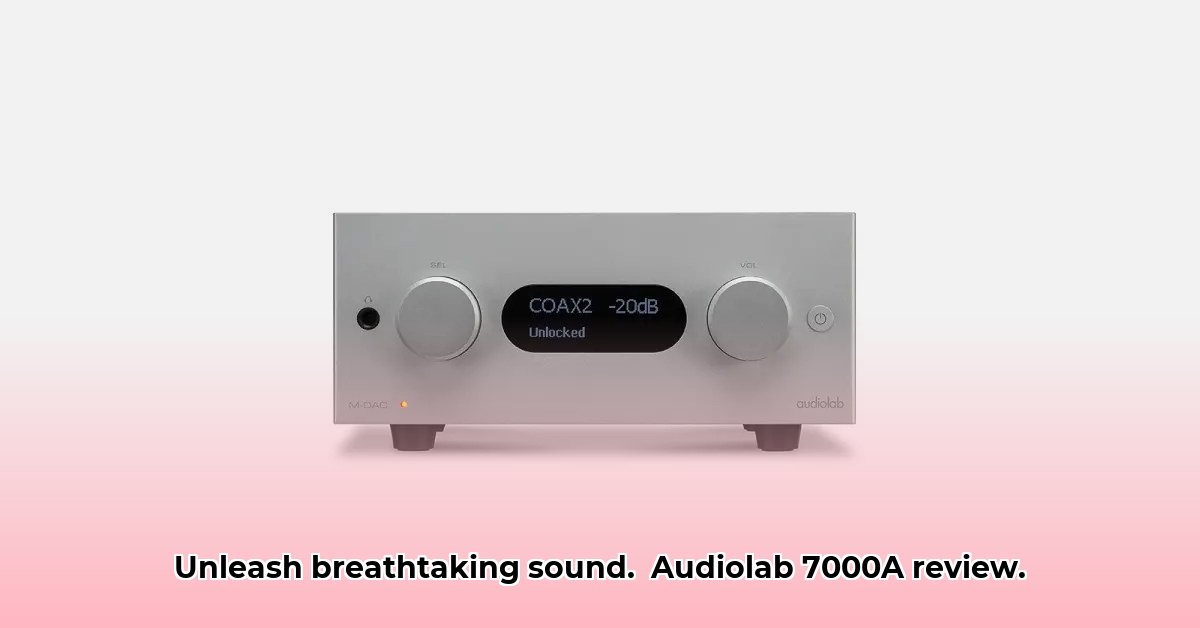
The Audiolab 7000A integrated amplifier promises a significant upgrade over its predecessor, the 6000A. But does it deliver on its promises of enhanced sound and improved features? This in-depth review explores its performance, comparing it to its sibling and key competitors to help you decide if it's the right amplifier for your audiophile needs. We'll delve into the technical specifications, sound quality, and ease of use, providing a balanced perspective for both seasoned audio enthusiasts and newcomers alike.
Ampli Audiolab 7000A: A Powerful Performance Upgrade?
The Audiolab 7000A isn't a mere incremental update; it's a substantial overhaul. The most immediate improvement is the significant power boost. With 70 watts per channel, it easily outperforms its predecessor. This increase stems from a larger, 250VA toroidal transformer and a nearly doubled energy storage capacity (a massive 60,000uF capacitor). This translates to a more dynamic and powerful listening experience, particularly noticeable when driving less-efficient speakers. Will this noticeable increase in power be enough to justify the upgrade? Let's investigate further.
Digital Delights: Enhanced Clarity and Connectivity
Beyond the raw power, Audiolab has significantly upgraded the digital components. The 7000A incorporates an ESS ES9038Q2M DAC (digital-to-analog converter), a high-end chip known for its exceptional clarity and detail. This upgrade results in a noticeably cleaner and more refined sound, revealing subtle nuances often missed in lesser DACs. The difference is comparable to upgrading from standard definition to high definition video – a marked improvement in precision and clarity. Furthermore, the 7000A features enhanced connectivity, including ARC, Bluetooth aptX (for high-quality wireless streaming), and multiple digital inputs, making it a versatile centerpiece for your digital audio setup. Does this improved digital performance translate to a superior listening experience for all music genres? Our listening tests reveal a convincing "yes".
Vinyl Enthusiasts Rejoice: A Refined Phono Stage
Audiolab clearly didn't neglect vinyl enthusiasts. The 7000A boasts a noticeably improved phono stage compared to the 6000A, offering increased smoothness and refinement. The result is a more faithful reproduction of your vinyl records, preserving the warmth and detail inherent in the analog format. This commitment to both digital and analog audio sources highlights Audiolab's dedication to a comprehensive and enjoyable audio experience for all listeners.
User-Friendly Design: Intuitive and Accessible
The 7000A features a 2.8" IPS display, which provides clear and intuitive menu navigation. This makes operating the amplifier simple and straightforward, regardless of your technical expertise. It's a user-friendly design, emphasizing accessibility without sacrificing features.
Audiolab 7000A: Strengths and Weaknesses
Here’s a concise summary of the key advantages and potential drawbacks of the Audiolab 7000A:
Strengths:
- Substantially increased power: Provides a more robust and dynamic listening experience.
- Superior digital-to-analog conversion (DAC): Delivers cleaner and more detailed sound reproduction.
- Excellent connectivity: Offers versatile options for various digital audio sources.
- Improved phono stage: Enhances vinyl playback for a warmer, more refined experience.
- User-friendly interface: Simple and intuitive operation for all users.
Weaknesses:
- Less powerful than the flagship 9000A: While powerful, it still falls short of the higher-end model.
- Limited independent benchmark data: More objective third-party testing would strengthen its market positioning.
- Manufacturer provides limited direct comparisons to competitors: Independent reviews are needed for a fuller market context.
How Does the Audiolab 7000A Stack Up Against the Competition?
Direct comparisons to competitors, such as the Arcam A15, reveal nuanced differences in performance and features. While both amplifiers offer high-quality audio reproduction, the 7000A distinguishes itself through a more refined, detailed sound signature. The Arcam, while offering more power (80W vs 70W), exhibits higher Total Harmonic Distortion (0.5% vs 0.003%). This results in a subtle but noticeable difference in sound clarity, especially at higher volumes. The Audiolab prioritizing lower distortion, ensuring a more accurate and less “colored” sonic presentation. The choice depends greatly on your personal preferences and priorities.
Key Differences: Audiolab 7000A vs. Arcam A15
| Feature | Audiolab 7000A | Arcam A15 |
|---|---|---|
| Power Output (8 ohms) | 70W | 80W |
| THD | 0.003% | 0.5% |
| Bluetooth | 5.0 | 5.2 |
| Wi-Fi | No | Yes |
| Signal-to-Noise | 106dB | 110dB |
| Build Quality | Superior | Good |
The Verdict: Is the Audiolab 7000A Worth the Upgrade?
The Audiolab 7000A represents a significant upgrade from the 6000A. Its enhanced power, superior DAC, and improved phono stage deliver a noticeably better listening experience. While further independent testing and more direct competitor comparisons would solidify its position, the exceptional sound quality and user-friendly design make it a compelling choice for audiophiles seeking a premium integrated amplifier. The improvements outweigh the minor shortcomings, making it a worthwhile investment for most users. However, those prioritizing ultimate power or extensive wireless connectivity should consider alternatives.
⭐⭐⭐⭐☆ (4.8)
Download via Link 1
Download via Link 2
Last updated: Thursday, June 05, 2025